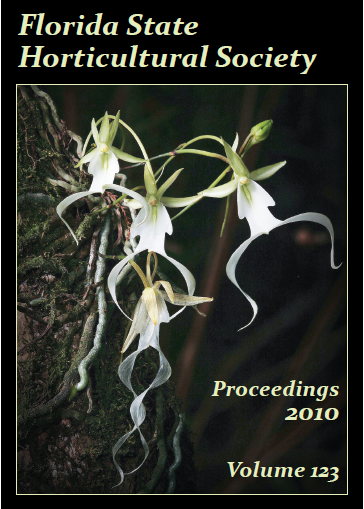Handling & Processing
Polygalacturonase Activity Does Not Fully Explain Textural Differences of Melting Flesh versus Non-melting Flesh Peaches
Abstract
Texture is the main distinction between melting-flesh (MF) and non-melting flesh (NMF) peach cultivars. MF peaches soften extensively toward the end of the ripening process while NMF peaches soften more slowly and lack the “melting” stage of fruit softening. Two pectolytic enzymes thought to be involved in peach softening are terminal cleaving exo-polygalacturonase (exo-PG) and random cleavingendo-PG. The decreased capacity of NMF peaches to degrade cell walls (i.e., soften) is thought to be related to a deletion of endo-PG gene or a truncation of the mRNA. Thus, NMF cultivars would be expected to possess lower endo-PG activity than MF cultivars. In this study, the extractable PG activity of two MF cultivars, ‘Flordaprince’ and ‘TropicBeauty’, and two NMF cultivars, ‘UFSun’ and ‘Gulfking’, during the climacteric ripening stage were determined. ‘Flordaprince’ possessed similar endo- and exo-PG activities as the two NMF cultivars while ‘TropicBeauty’ had the highest endo- and exo-PG activities of the four cultivars. Surprisingly, the endo-PG activity of NMF ‘Gulfking’ was significantly higher than its exo-PG activity and was also higher than that of MF ‘Flordaprince’. However, the higher endo-PG activity of ‘Gulfking’ was not reflected in its texture since it was almost five times firmer when ripe than ‘Flordaprince’(10.77 N vs. 2.34 N), which implies that endo-PG activity does not fully explain the textural differences between MF and NMF peaches. Since cell wall disassembly presumably involves concerted and synergistic action of several different enzymes, other cell wall modifying enzymes may have a more crucial role than PG during peach fruit softening.References
- Callahan, A.M., R. Scorza, C. Bassett, M. Nickerson, and F.B. Abeles. 2004. Deletions in an endopolygalacturonase gene cluster correlate with non-melting flesh texture in peach. Func. Plant Biol. 31:159–168.
- Carrington, C.M.S., C. Greve, and J.M. Labavitch. 1993. Cell wall metabolism in ripening fruit. Plant Physiol. 103: 429–434.
- Delwiche, M.J. and R.A. Baumgardner. 1985. Ground color as a peach maturity index. J. Amer. Soc. Hort. Sci. 110:53–57.
- Downs, C.G. and C.J. Brady. 1990. Two forms of exopolygalacturonase increase as peach fruits ripen. Plant, Cell Environ. 13:523–530.
- Fishman, M.L., B. Levaj, and D. Gillespie. 1993. Changes in the physic-chemical properties of peach fruit pectin during on-tree ripening and storage. J. Amer. Soc. Hort. Sci. 118:343–349.
- Jeong, J., D.J. Huber, and S.A. Sargent. 2002. Influence of 1-methylcyclopropene (1-MCP) on ripening and cell-wall matrix polysaccharides of avocado (Persea americana) fruit. Postharv. Biol. Technol. 25:241–256.
- Lester, D.R. and B.J. Atwell. 1994.Endopolygalacturonase and the melting flesh (M) locus in peach. J. Amer. Soc. Hort. Sci. 121:231–235.
- Manganaris, G.A., M. Vasilakakis, G. Diamantidis, and I. Mignani. 2006. Diverse metabolism of cell wall components of melting and non-melting peach genotypes during ripening after harvest or cold storage. J. Sci. Food Agr. 86:243–250.
- Milner, Y. and G. Avigad. 1967. A copper reagent for the determination of hexuronic acids and certain ketohexoses. Carboydr. Res. 4:359–361.
- Morgutti, S., N. Negrini, F.F. Nocito, A. Ghiani, D. Bassi, and M. Cocucci. 2006. Changes in endopolygalacturonase levels and characterization of a putative endo-PG gene during fruit softening in peach genotypes with nonmelting and melting flesh fruit phenotypes. New Phytologist 171:315–328.
- Orr G. and C. Brady. 1993. Relationship of endopolygalacturonase activity to fruit softening in a freestone peach. Postharv. Biol. Technol. 3:121–130.
- Pressey, R. and J.K. Avants. 1978. Differences in polygalacturonase composition of clingstone and freestone peaches. J. Food Sci. 30:573–576.
- Pressey, R. and J.K. Avants.1973a. Separation and characterization of endopolygalacturonaseand exopolygalacturonase from peaches. Plant Physiol. 52:252–256.
- Pressey, R. and J.K. Avants. 1973b. Two forms of polygalacturonase in tomatoes. Biochim. Biophys. Acta 309:363–369.
- Shewfelt, A.L., V.A. Paynter, and J.J. Jen. 1971. Textural changes and molecular characteristics of pectic constituents in ripening peaches. J. Food Sci. 36:573–575.
- Smith, P.K., R.I. Krohn, G.T. Hermanson, A.K. Mallia, F.H. Gartner, M.D. Provenzano, E.K. Fujimoto, N.M. Goeke, B.J. Olson, and D.C. Klenk. 1985. Measurement of protein using biccinchoninic acid. Anal.Biochem. 150:76–85.

